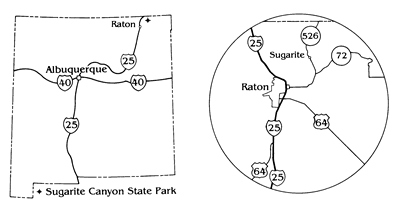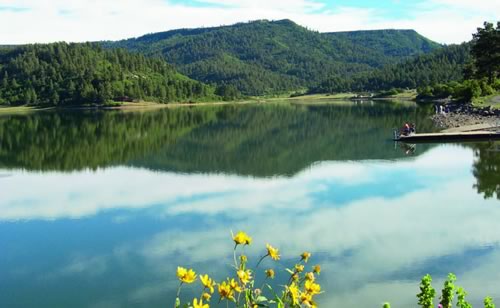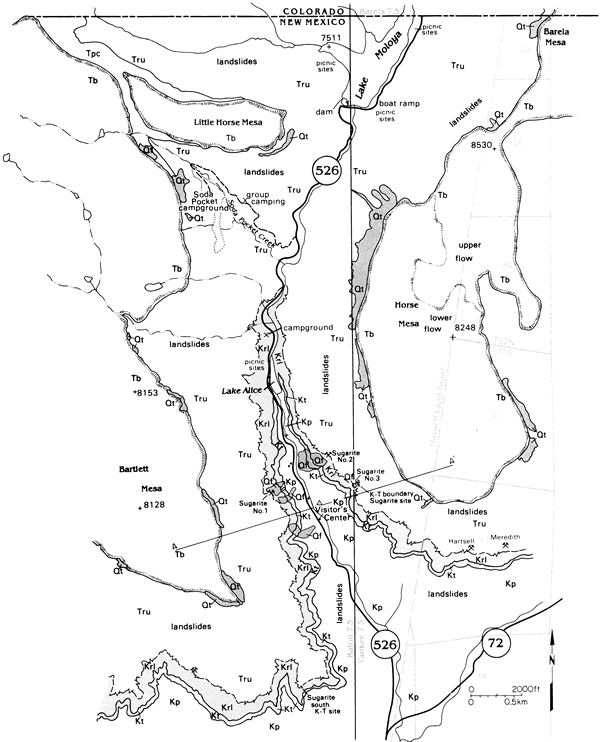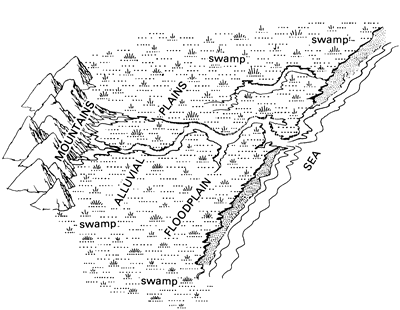
Sugarite Canyon State Park
modified and updated from McLemore, V.T., 1990, Sugarite Canyon State Park: New Mexico Geology, v. 38-42 and
McLemore, V. T., 2010, Sugarite Canyon State Park, in The geology of northern New Mexico's parks monuments, and public lands: Price, L. Greer, ed., p. 341-345.
Introduction


William Muehlberger
Sugarite Canyon State Park, once the site of a thriving coal-mining camp, was established as a state park in 1985, but the canyon has been a recreational attraction in northeastern New Mexico for decades. Sugarite Canyon State Park is located about 5 miles northeast of Raton via NM-72 and NM-526 (paved) (Fig. 1). The elevation in the park ranges from about 6,900 ft to 8,400 ft. This heavily wooded mountain park has something for everyone year round. Trails are maintained through the ruins of the settlement and past coal dumps and mines. Boating in the two lakes (Fig. 2) and and camping is popular.
Sugarite is believed to be the anglicized version of Chicarica, the original name of the canyon and adjacent mesa. Chicarica is derived from either the Spanish name, chicory, for the wild endive plant growing in the canyon or from the Comanche or Ute name for a species of spotted bird which lived in the canyon (Pearce, 1965; Keleher, 1984).
Geology
Sugarite Canyon State Park is part of the Raton Basin, a structural basin that extends from Cimarron, New Mexico, northeastward to Huerfano Park, Colorado, about 100 mi long and as much as 60 mi wide (Woodward, 1987). The basin formed during Laramide deformation between about 70 and 50 million years ago as the San Luis Highland rose to the west. Erosion of the highlands during and after uplift provided sediment that filled the basin (Pillmore and Flores, 1987).


The oldest rocks exposed in Sugarite Canyon formed from mud deposited in the Cretaceous sea and belong to the Late Cretaceous Pierre Shale. The Pierre Shale is overlain by the white sandstones of the Trinidad Sandstone that were deposited in deltafront and barrier environments along the coast of the Cretaceous sea (Figs. 3, 4, 5; Pillmore and Flores, 1987).
As the Cretaceous seas receded eastward away from New Mexico, the coastal margin also migrated eastward. Sand, which later solidified into sandstone, was deposited by meandering rivers and streams, whereas mud, which became shale was deposited in the adjacent floodplains. Peat, which became coal, was deposited in poorly drained swamps (Figs. 3, 4, 5). The floodplain and alluvial-plain deposits (Fig. 5), known as the Raton Formation, were deposited unconformably on top of the Trinidad Sandstone. The Raton Formation is of Late Cretaceous (about 66 m.y.) to Paleocene (about 57 m.y.) age and consists of about 1,100 ft of sandstone, siltstone, mudstone, coal, conglomerate, and carbonaceous shale. Ferns, leaf imprints, and other plant material can be found in this unit. The Raton Formation is divided into three zones: the lower coal zone, the barren series, and the upper coal zone (Pillmore and Flores, 1987). The Sugarite coal bed is at the top of the 100-ftthick lower coal zone. This unit consists of a basal conglomerate (not present in the park) and sandstone overlain by interfingering sandstone, shale, mudstone, and coal. The Sugarite coal is the lowest economic grade of coal in the Raton Formation. In other areas of the Raton Basin the coals in the lower zone are not of economic thickness or quality.

The coal is bituminous and almost 6 ft thick at the Sugarite mines. It is noncoking (lower percentage of carbon content and higher percentage of ash) but has a high heating value and burns freely without much clinker (Lee, 1924; Pillmore, 1976). The Sugarite mines were adits, tunnels driven into the hillside along the coal seams. Mules were used in the mines to move coal cars to the surface where a tram was built to haul the coal down the steep slopes to the bottom of the canyon (Lee, 1924). Railway cars transported the coal to Raton where it was used as domestic fuel and as fuel to power the locomotives. Total coal production from Sugarite amounted to 562,497 tons or less than 1% of the total coal production from Colfax County (New Mexico State Mine Inspector's reports).

The lower coal zone contains Cretaceous-age rocks with the Cretaceous–Tertiary boundary at or near the top of the zone (Pillmore and Flores, 1987). At Sugarite, this boundary is indicated by 1–2-inch-thick kaolinite-rich clay near the top of the Sugarite coal. This clay bed is characterized by anomalously high concentrations of iridium and other platinum-group metals, along with the absence of certain pollen species and the presence of shock-metamorphosed quartz and feldspar grains (Pillmore et al., 1984; Pillmore and Flores, 1987; Orth et al., 1987). Iridium is found in very low concentrations in rocks of the Earth's crust but is more concentrated in meteorites and rocks from deeper in the crust. This clay bed has been found throughout the Raton Basin and in a narrow belt that extends from New Mexico to Alberta, Canada. The Cretaceous–Tertiary boundary is known throughout the world for the mass extinction of numerous animal and plant species, including dinosaurs.
Interpretations of the Cretaceous–Tertiary boundary are controversial. Many scientists believe the mass extinctions at that time were a result of a catastrophic event, such as the impact of a large meteor or asteroid that produced the shock-metamorphosed mineral grains (Pillmore and Flores, 1987; Alvarez et al., 1980; Orth et al., 1987). Other scientists believe the mass extinctions were a result of a series of intense volcanic eruptions (Officer and Drake, 1985). The impact theory and the volcanic-eruption theory further suggest that a large amount of dust was ejected into the atmosphere, blocking sunlight and resulting in the decline of plant life and subsequently animal life that depended on plants for food. This material settled and formed the boundary layer we now see in both marine and nonmarine sedimentary rocks throughout the world. Other scientists believe the mass-extinction event has been exaggerated; instead they suggest extinction occurred over a period of several million years. Sedimentary rocks deposited at this time may have been eroded, so the problem may be simply missing rocks, not mass extinctions (Archibald and Clemons, 1982; Rigby and Fassett, 1989). Dinosaur bones are found in rocks stratigraphically above the Cretaceous-Tertiary boundary; but these bones may have been eroded and actually may be late Cretaceous in age. However, dinosaur footprints are found only in the late Cretaceous rocks beneath the Tertiary-Cretaceous boundary, thereby providing evidence for the mass extinctions (Adrian Hunt, personal communication, August 2000). Additional work is needed to resolve this controversy.
Most of the barren series and upper coal zone in Sugarite Canyon are covered by vegetation, landslide debris, and debris from the basaltic mesa caprocks. The barren series consists of approximately 500 feet of cliff-forming channel sandstone with minor slope-forming siltstone, shale, mudstone, and a few very thin coal seams. These rocks were deposited by meandering streams and in adjacent floodplain and alluvial-plain environments (Flores and Pillmore, 1987; Pillmore and Flores, 1987). The upper coal zone, above the barren series, consists of approximately 500 feet of floodplain sandstone, mudstone, siltstone, and shale interbedded with coal and carbonaceous shale that were deposited in swamps. Exposures of the upper coal zone can be seen near the dam at Lake Maloya.
Tertiary basalt flows overlie sedimentary rocks and cap the mesas bordering Sugarite Canyon State Park. They are part of the extensive Raton-Clayton volcanic field, which extends from Fishers Peak Mesa, northeast of Raton to Rabbit Ear Mountain, near Clayton. The volcanic rocks forming this field were erupted in three phases: the Raton olivine basalts and andesites at about 9–3.6 million years ago, the Clayton olivine basalts at about 3–2.2 million years ago, and the Capulin alkali olivine basalts and andesites at about 1.7 million years to 56,000 years ago (Stroud, 1997). The flows in Sugarite State Park were erupted as broad flow sheets ranging in thickness from 10 to 100 feet. The basalt is fine to coarse grained and consists of olivine and plagioclase phenocrysts (Stormer, 1972a, b); it about 7–9 million years old and is part of the Raton phase (Stroud, 1997). Hiking trails at Little Horse Mesa and Horse Mesa allow the visitor to examine the basalt up close.
After eruption of the basalt, the Sugarite-Raton area continued to be uplifted and eroded. An erosional process called volcanic inversion of relief formed many of the canyons in the Raton-Clayton area, such as Sugarite Canyon. The basalt originally flows into existing canyons, filling them. Over time, the sediments forming the ridges at the time the basalts were erupted were themselves eroded, leaving the harder, more resistant basalt as ridges today. Even today, this erosion is continuing.
Landslides and talus slopes are common along the base of the basalt flows. This material was displaced after Sugarite Canyon was formed. Rain and snow melt seep into cracks or cooling joints of the exposed rock surfaces. When the water freezes, it expands the cracks and eventually causes the rock to break into angular boulders, which slowly move downhill forming a talus slope of broken rubble. Rock falls and mud slides still occur today.
References
- Alvarez, L. W., Alvarez, W., Asaro, F., and Michel, H. V., 1980, Extraterrestrial cause for the Cretaceous-Tertiary extinction: Science, v. 208, p. 1095-1108.
- Archibald, J. D., and Clemens, W. A., 1982, Late Cretaceous extinctions: American Scientist, v. 70, p. 377-385.
- Flores, R. M., 1987, Sedimentology of Upper Cretaceous and Tertiary siliciclastics and coals in the Raton Basin, New Mexico and Colorado: New Mexico Geological Society, Guidebook to 38th Field Conference, p. 255264.
- Flores, R. M., and Pillmore, C. L., 1987, Tectonic control in alluvial paleoarchitecture of the Cretaceous and Tertiary Raton Basin, Colorado and New Mexico; in Ethridge, F. G., Flores, R. M., and Harvey, M. D. (eds.), Recent developments in fluvial sedimentology: Society of Economic Paleontologists and Mineralogists, Special Publication 39, p. 311-320.
- Lee, W. T., 1924, Coal resources of the Raton coal fields, Colfax County, New Mexico: U.S. Geological Survey, Bulletin 752, 254 p.
- McLemore, V. T., 2010, Sugarite Canyon State Park, in The geology of northern New Mexico's parks monuments, and public lands: Price, L. Greer, ed., p. 341-345.
- Officer, C. B., and Drake, C. L., 1985, Terminal Cretaceous environmental events: Science, v. 227, p. 1161-1167.
- Orth, C. J., Gilmore, J. S., and Knight, J. D., 1987, Iridium anomaly at the Cretaceous-Tertiary boundary in the Raton Basin: New Mexico Geological Society, Guidebook to 30th Field Conference, p. 265-269.
- Pillmore, C. L., 1976, Commercial coal beds of the Raton coal field, Colfax County, New Mexico: New Mexico Geological Society, Guidebook to 27th Field Conference, p. 227-247.
- Pillmore, C. L., and Flores, R. M., 1987, Stratigraphy and depositional environments of the Cretaceous-Tertiary boundary interval and associated rocks, Raton Basin, New Mexico and Colorado; in Fassett, J. E., and Rigby, K. B., Jr. (eds.), Cretaceous-Tertiary boundary of the San Juan and Raton Basins, northern New Mexico and southern Colorado: Geological Society of America, Special Paper 209, p. 111-130.
- Pillmore, C. L., Tschudy, R. H., Orth, C. J., Gilmore, J. S., and Knight, J. D., 1984, Geologic framework of nonmarine Cretaceous-Tertiary boundary sites, Raton Basin, New Mexico and Colorado: Science, v. 223, no. 4641, p. 1180-1182.
- Rigby, J. K., Jr., and Fassett, J. E., 1989, Local CretaceousTertiary stratigraphic problems and interpretations of global events surrounding continental boundary: 28th International Geological Congress, Abstracts, v. 2, p. 698-699.
- Scott, G. R., 1986, Historic trail maps of the Raton and Springer 30' x 60' quadrangles, New Mexico and Colorado: U.S. Geological Survey, Miscellaneous Geologic Investigation, Map 1-1641, scale 1:100,000, 10 p.
- Scott, G. R., and Pillmore, C. L., 1989, Geologic and structure contour maps of the Raton 1/2° x 1° quadrangle, Colfax and Union Counties, New Mexico and Las Animas County, Colorado: U.S. Geological Survey, Openfile Report 89-282, scale 1:100,000.
- Stormer, J. C., Jr., 1972a, Mineralogy and petrology of the Raton-Clayton volcanic field, northeastern New Mexico: Geological Society of America, Bulletin, v. 83, p. 3299-3322.
- Stormer, J. C., Jr., 1972b, Ages and nature of volcanic activity on the southern High Plains, New Mexico and Colorado: Geological Society of America, Bulletin, v. 83, p. 2443-2448.
- Stroud, J. R., 1997, The geochronology of the Raton-Clayton volcanic field, with implications for volcanic history and landscape evolution: M. S. thesis, New Mexico Institute of Mining and Technology, Socorro, 170 p.
- Woodward, L. A., 1987, Tectonic framework of northeastern New Mexico and adjacent parts of Colorado, Oklahoma, and Texas: New Mexico Geological Society, Guidebook to 38th Field Conference, p. 67-71.
- Veltri, P. and Walsh, P.H., 2018, Sugarite coal camp: Arcadia Publishing, Charleston, South Carolina, 128 p.
Updated October 13, 2021.



